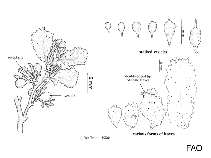Sargassum paniculatum J. Agardh
Serrate sargassum| Native range | All suitable habitat | Point map | Year 2050 |

|
| This map was computer-generated and has not yet been reviewed. |
| Sargassum paniculatum AquaMaps Data sources: GBIF OBIS |
Upload your photos
Google image | No image available for this species;
drawing shows typical species in Sargassaceae.
Google image | No image available for this species;
drawing shows typical species in Sargassaceae.
Classification / Names Common names | Synonyms | CoL | ITIS | WoRMS
Phaeophyceae | Fucales | Sargassaceae
Environment: milieu / climate zone / depth range / distribution range Ecology
Sessile. Tropical
Distribution Countries | FAO areas | Ecosystems | Occurrences | Introductions
Atlantic and Indo-Pacific oceans.
Length at first maturity / Size / Weight / Age
Maturity: Lm ? range ? - ? cm
Short description Morphology
Holdfast shield-shaped to discoid, massive in some where 2 or more thalli arise from a fused holdfast; stem up to 25 mm long, cylindrical, warty. Primary branches terete, smooth. Secondary branches terete, alternately attached irregularly on the primary branch, smooth. Leaves of secondary branches of vegetative thallus mainly ovate-lanceolate to oblong to linear-lanceolate; base unequal; margin generally serrate, entire in some; apex generally obtuse to acute; midrib distinct but disappearing near apex; cryptostomata numerous and scattered. Leaves in fertile materials mainly linear to linear-lanceolate, some linear-oblanceolate, up to 40 mm long and 4 to 5 mm wide; base acute, slightly unequal; margin dentate-serrate, entire in some; apex narrowly acute; midrib distinct. Cryptostomata sparse
in leaves of primary laterals, sparse and scattered in leaves of secondary laterals, but distinct and with tendency to be arranged in rows in narrow leaves of terminal branches. Vesicles numerous, spherical or obovate, blunt; base plain or ear-like or with narrow extended margin; mainly small in fertile materials; racemose; vesicles 1 to 2 mm long, with very short stalks, 1 or less than 1 mm long. Plant dioecious. Male receptacles racemose, up to 15 mm long, pinched in here and there, 0.3 to 0.5 mm in diameter (in dried material) with blunt tip. Female receptacles racemose; receptacular branches compressed to triquetrous, with edges or margins finely serrate to dentate, up to 6 mm or sometimes longer, sometimes slightly twisted. Primary branches up to 80 cm (rarely to 175 cm) in length (Ref. 80758).
Used for human consumption mainly as emulsifying, stabilizing and gelling agents in food products such as frozen food, pastries, desserts, jellies, salad dressings, ice creams, meat and flavor sauces, beer, fruit juices, and milk shakes; contains iodine, protein, vitamin C, and minerals like Ca, K, Mg, Na, Cu, Zn, S, P, Mn); used as medicine: for goiter, glandular troubles, antibacterial, antitumor; source of tannins and phenols; also used for animal feed and fertilizer (Ref. 80758).
Life cycle and mating behavior Maturity | Reproduction | Spawning | Eggs | Fecundity | Larvae
Main reference
References | Coordinator | Collaborators
Guiry, M.D. and G.M. Guiry. 2009. (Ref. 80701)
IUCN Red List Status (Ref. 130435: Version 2024-1)
CITES status (Ref. 108899)
Not Evaluated
CMS (Ref. 116361)
Not Evaluated
Threat to humans
Harmless (Ref. 80758)
Human uses
Fisheries: commercial
| FishSource |
Tools
More information
Trophic Ecology
Food items
Diet
Food consumption
Ration
Predators
Diet
Food consumption
Ration
Predators
Ecology
Population dynamics
Growth
Age/Size
Length-weight
Length-length
Length-frequencies
Mass conversion
Recruitment
Abundance
Age/Size
Length-weight
Length-length
Length-frequencies
Mass conversion
Recruitment
Abundance
Life cycle
Reproduction
Maturity
Fecundity
Spawning
Eggs
Egg development
Larvae
Larval dynamics
Maturity
Fecundity
Spawning
Eggs
Egg development
Larvae
Larval dynamics
Distribution
Human Related
Aquaculture profile
Stamps, Coins Misc.
Stamps, Coins Misc.
Outreach
References
Internet sources
BHL | BOLD Systems | CISTI | DiscoverLife | FAO(Publication : search) | Fishipedia | GenBank (genome, nucleotide) | GloBI | Gomexsi | Google Books | Google Scholar | Google | PubMed | AlgaeBase | Tree of Life | Wikipedia (Go, Search) | Zoological Record



